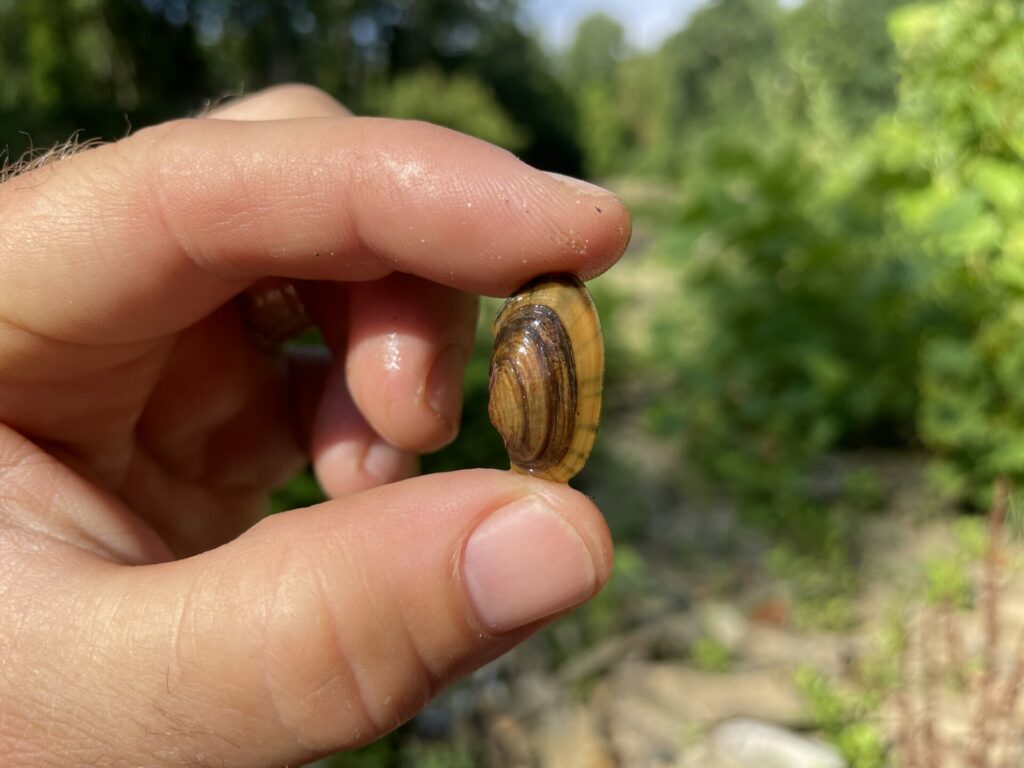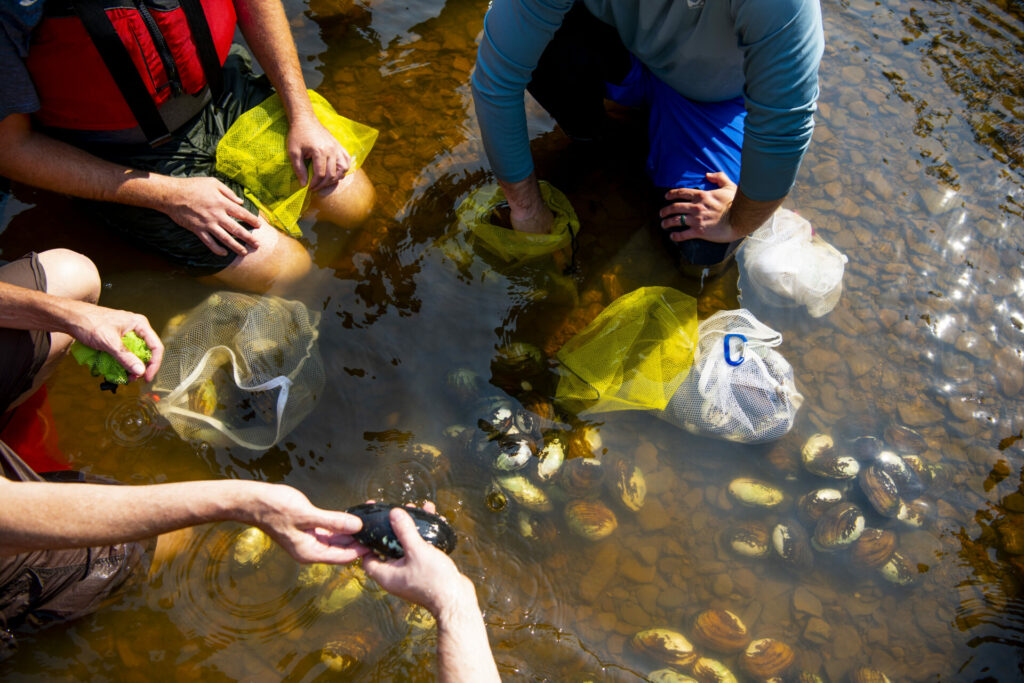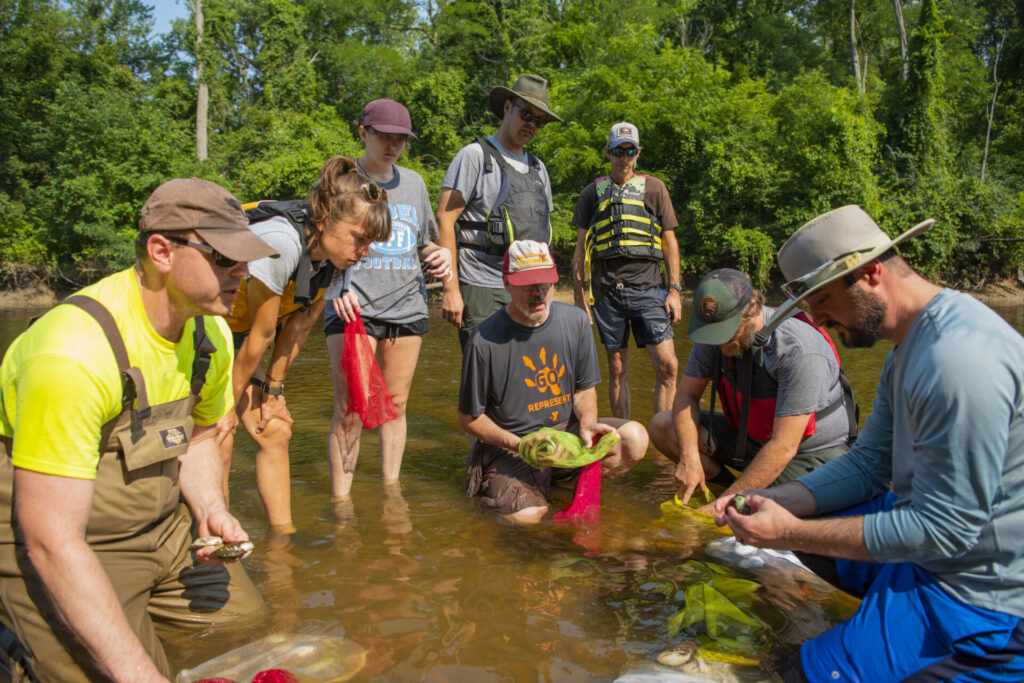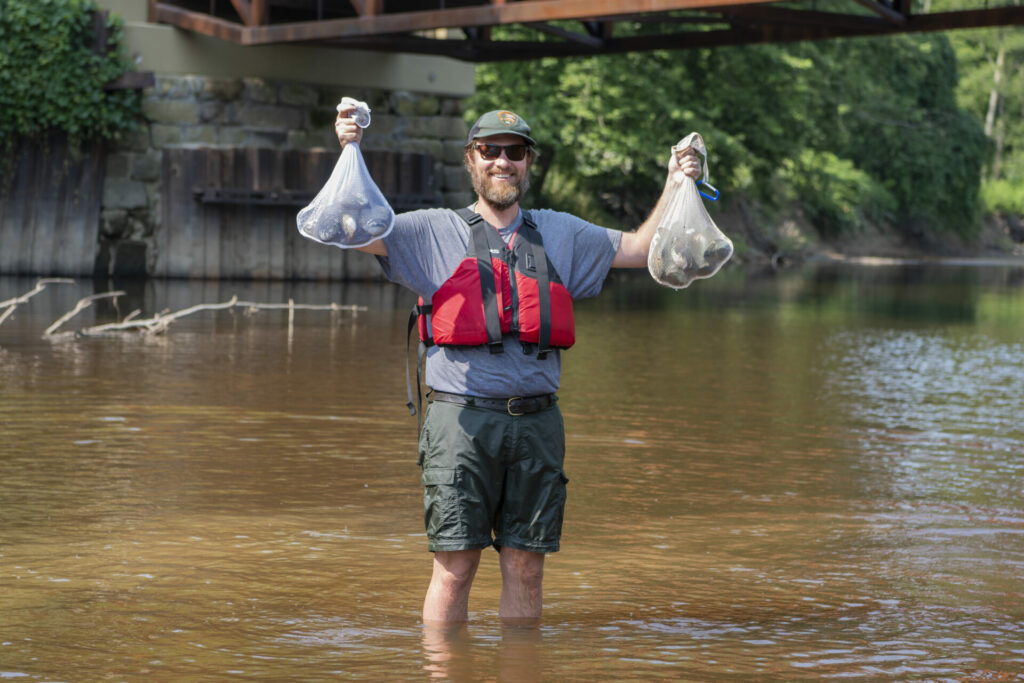By Kelly McGreal / Photos by Ryan Grzybowski
Depending on size and species, a freshwater mussel can filter over eight gallons of water a day, pulling it through specialized gills. Pretty impressive, right? Now imagine an entire bed of mussels—hundreds of them—each one filtering water like a living water pump. If it’s hard to visualize, it’s probably because most of us have never seen robust mussel beds. Embedded on the bottoms of ponds, lakes, and rivers, it’s easy to mistake them for a pile of rocks. But there’s another reason why many of us haven’t seen freshwater mussels: they’re not as common as they used to be. In fact, most species are at-risk or endangered, and some are already extinct.
While it’s true freshwater mussels still thrive in some places, native mussel populations are absent or declining in many areas. Here in Cuyahoga Valley National Park (CVNP), native mussel populations are missing from the Lower Cuyahoga River, but biologists think it’s time for reintroduction!

LOW MUSSEL MASS: WHERE HAVE ALL THE MUSSELS GONE?
Mussels exist throughout the world, and North America has the highest diversity of mussels with over 300 species. While this number is remarkable, reports estimate that 70% of them are at risk of extinction. Habitat loss and pollution, which affect mussels’ ability to reproduce and survive, are major factors in why we’re seeing declining populations.
To understand why mussels are so vulnerable to environmental changes, it’s important to learn a bit about their life cycle. Did you know that fish help mussels reproduce? After mussel eggs are fertilized, they develop into larvae called glochidia and are released like tiny confetti. If it sounds like a party is about to get started, you’re right. Glochidia attach to the gills of a fish who unwittingly becomes the host with the most, providing a life-changing ride through the water. During this time, glochidia grow into juvenile mussels, but every get-together must come to an end. Young mussels eventually drop off the host fish. If conditions are right, they burrow into the substrate and head to bed—a mussel bed they form at the bottom of the river.
Mussel reproduction is pretty unusual, and some mussels require a specific kind of fish host for glochidia. Other mussel species are considered “generalists.” They aren’t so picky—a number of fish can serve as hosts. In either case, mussels need fish. Without them, their life cycle grinds to a halt. Unfortunately, the host fish necessary for reproduction aren’t available to many freshwater mussel species due to pollution and habitat loss.
By now, most of us know about the Cuyahoga River’s infamously polluted past. In the late 1960s, the heavily contaminated water barely sustained aquatic life, including host fish vital to the reproductive cycle of mussels. Even if fish somehow survived severe water pollution, mussels could not. As filter feeders, they are sensitive to contaminants since bacteria, chemicals, and other non-organic particles are drawn through their gills as they eat.
To make matters worse, mussels and the fish that help them have also been impacted by habitat loss. Dams, first used for agriculture and later for industry, have been part of the Cuyahoga River since the 1820s. Though technologically innovative, dams dramatically affect ecosystems. They impact water and sediment quality, alter habitat, and block some fish (including host fish) from migrating. This has been true for the Lower Cuyahoga River. If the picture seems bleak, read on, because this is a story of restoration and hope.

GROWTH POTENTIAL
We know from archeological records that freshwater mussels are native to the Cuyahoga Valley, and there is evidence that prehistoric peoples living here had a variety of uses for mussels and their shells. As it turns out, some mussels can still be found in the Upper Cuyahoga River, but the same cannot be said for the Lower Cuyahoga, which includes over 25 miles of river running through CVNP. If mussels were once part of the park’s ecosystem, could they thrive here again? Scientists think so.
The health of the river steadily improved after the passage of the Clean Water Act of 1972, and its ecological comeback is impressive. CVNP Biologist Ryan Trimbath explains:
“We’ve improved water quality, riverine habitat, and riparian areas, and we’ve seen the return of wildlife—river otters are back, bald eagles are nesting, and there are lots of fish.”
Now over fifty fish species can be found in the river. This includes stonecat madtom catfish, river chub, and northern pike, which are sensitive and require high water quality. The fact that they’re here is a good sign.
Along with improvements in water quality, Trimbath says the removal of the Canal Diversion Dam from the river in 2020 was a “game changer” for CVNP. Demolishing the dam connected over 20 miles of the Lower Cuyahoga River to Lake Erie once again. Fish are now able to move freely upstream as far as the Gorge Dam in Cuyahoga Falls. Healthier water and the ability for fish to migrate bodes well for freshwater mussel reintroduction. But to see whether the Lower Cuyahoga River can support and grow mussel beds, scientists needed to put it to the test—a fitness test.

PASSING THE FITNESS TEST
Mussels need a relatively clean aquatic environment to survive. In 2021, scientists in CVNP placed 70 adult Mucket mussels in the Lower Cuyahoga River. For 70 days, the mussels stayed in mesh cages, pulling the river water through their sensitive gills—90% lived! The results were encouraging, but scientists wondered if younger, more vulnerable mussels could also make it. To find out, they’d need juvenile mussels. Enter the Genoa National Fish Hatchery (GNFH), located in Wisconsin.
Managed by the U.S. Fish and Wildlife Service, the hatchery focuses on recovering at-risk aquatic animals such as freshwater mussels. GNFH donated 300 young Fatmucket mussels, a generalist species native to the Midwest, for the park’s study. Once here, scientists put the mussels in specially designed silos and placed them at six separate sites, five in the Lower Cuyahoga River and one in the Grand River in Painesville, Ohio.
From June to September 2022, researchers studied water conditions, sediment buildup in silos, and mussel growth. Though some mussels died, Fatmuckets at the Cuyahoga and Grand River sites had similar survival rates, hovering around 50%. While that number may seem low to some, scientists were pleased. They suspect most mussel deaths resulted from sediment clogging the silos, which wouldn’t be an issue if mussels were freely reintroduced to the river. Overall, the study was a success. Young mussels survived and grew. The river passed the fitness test.

GROWING MUSSELS, GROWING KNOWLEDGE
For scientists monitoring the river’s health, the results of the 2021 and 2022 studies inspired hope. That mussels in the Lower Cuyahoga did nearly as well as those in the Grand River is promising. The two rivers have similar conditions, yet the Grand River already has diverse, robust freshwater mussel beds. This leads scientists to believe the Lower Cuyahoga can grow and support mussels, too. The river seems ready for a reintroduction. As Trimbath puts it, “We’re not seeing a stop sign. We’re seeing a proceed with caution sign. We’ve built a research component into our reintroduction effort to guide an adaptive process for restoration.”
Funded by the National Park Foundation, mussel reintroduction to the Lower Cuyahoga is set to begin this fall. Fatmucket mussels collected upstream near Kent are being propagated by GNFH. Once ready, hundreds of one-year-old mussels will be introduced to river sites researchers select this summer. Some of the mussels will be held back until they are two years old and released the following year. Trimbath explains:
“This is phase one—just the beginning of a larger effort to rebuild diverse and robust mussel beds in the Cuyahoga River.”
If reintroduction is successful, the presence of freshwater mussel beds will be a bio-indicator of a healthy river with good water quality. Not only do mussel beds signal water health, but their presence further improves aquatic environments. Trimbath notes, “Mussels are tricky. They require clean water, but they also clean the water.” Along with filtering water, they stabilize the river bottom, provide habitat for fish or other small aquatic animals, and serve as a food source for wildlife. Reintroducing mussels to the Lower Cuyahoga River will benefit CVNP’s entire ecosystem, and it looks like the river is ready.
Trimbath is hopeful that the work done in CVNP will have impacts that extend beyond the park, saying:
“Freshwater mussel restoration science is relatively new. Most efforts have focused on conservation of threatened and endangered species. The science being done here will help inform future efforts to restore relatively common species into rivers with a long history of human impacts where mussels may be completely absent today.”

The article originally appeared in the SPRING / SUMMER 2023 issue of the Conservancy Member Magazine.





